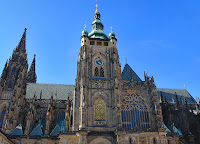Shakespeare gives the famous description of "Bohemia, a desert country by the sea" in his play A Winter’s Tale. Bohemia today is part of the Czech Republic and one of the greenest and most beautiful holidaying regions in Central Europe. But there was system to the madness of Shakespeare's description.
The region of Bohemia (in Czech called Čechy) makes up the western two thirds of the Czech Republic, the remainder being made up by Moravia and Czech Silesia. It’s political, historical, and cultural center is the city of Prague. A picture-map from 1570 shows Bohemia not only at the heart of Europe but as its heart. You will also see on the map that Germany is on it, but Austria isn't. The time for Austria under the Hapsburg was still in the future at that time.
Bohemia is hemmed in by four mountain ranges. The Bohemian Forest (Czech Šumava) marks the borders with Bavaria and Upper Austria, the Ore Mountains (Czech Krušné hory) with Saxony, the Sudetes (Czech Krkonošsko-jesenická subprovincie) with Saxony and Silesia, and the Bohemian-Moravian Highlands (Czech Českomoravská vrchovina) with Moravia and Lower Austria.
The landscape of Bohemia is and was defined by wooded mountainsides and many farms; it was a green and fertile area at the center of Europe. There was certainly no access to any sea there, and it was far from being a desert. Historically, though, the kings of Bohemia had twice extended their personal sphere of influence to stop just miles short of reaching either the Adriatic under Ottokar II or the Baltic under Charles IV (Emperor of the Holy Roman Empire).
Shakespeare was not above taking a dig at the most powerful man of his time: The King of Bohemia. Better known as Rudolf II of Hapsburg, Emperor of the Holy Roman Empire and King of Hungary, that worthy had moved the empire’s political center from Vienna to Prague in 1609. Members of the Hapsburg dynasty ruled domains encompassing the world where the sun never set and which were bordering on every known ocean. Yet Rudolf chose Prague as the capital of all this, Prague the capital of a pint sized kingdom albeit his own. But despite that, Bohemia would remain a small country in the center of Europe. King James would have understood and enjoyed the dig at the Bohemian.
Shakespeare was a master in the use of the adynaton to convey whole layers of meaning to his audience and this one is a prime example. The word adynaton derives from Greek adynatos (impossible). The idea is to express something impossible to convey the real meaning of what is said. An adynaton is often, but not always, formulated as a comparative construction where an impossible thing is alleged to happen sooner than something conceivably possible. A well known example for this kind of sentence is ‘And again I say unto you, it is easier for a camel to go through the eye of a needle, than for a rich man to enter into the kingdom of God.’ (Matthew 19,24.)
Further reading






No comments:
Post a Comment